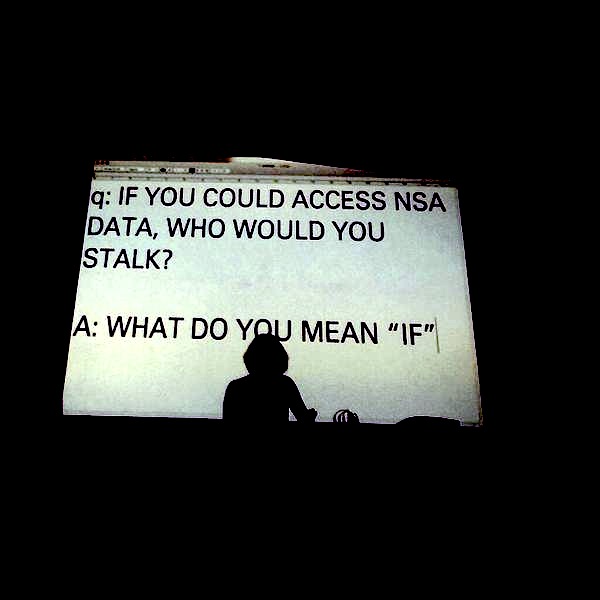Event Review: Holly Herndon at the Wick
The composer marks the release of her new LP with an immersive art event in Bushwick.

Q: If you could access NSA data, who would you stalk? A: What do you mean “if”
The answer appeared on the screen almost as quickly as the question did, texted in from a member of the few thousand strong audience standing in the industrial expanse of Bushwick, Brooklyn venue the Wick. This was far more than an average gig though—it was a multifaceted, audio-visual dialog that stretched across the room’s active and passive participants, the Internet, and beyond. At its helm was Holly Herndon, celebrating the recent release of her second album, Platform.
Three years on from Holly’s debut LP Movement, the Stanford PhD candidate changed her approach as a purely solo producer on Platform, looking further afield to collaborate with a wide variety of artists across many mediums. Self-described as a “paradisic gesture” focusing on our relationship with technology, Platform explores themes like surveillance and unequal systems through a lens of optimism. It presents new ways for us to love and use machines for our betterment, yet doesn’t gloss over the duality of their ever-present ability to hurt and destroy.
Tonight’s show managed to encompass all of this. Evan Caminiti’s textural, ambient apocalypse and GABI’s experimental operatics were the two wildly diverse openers. Pink noise blared out between the sets, ostensibly acting as a reset button. Herndon delved into material from both of her albums; reworking her tracks for the live setting with an emphasis on their propulsive beats and angular structures that seemed to draw heavily on the many years she spent living in Berlin. On the Wick’s booming sound system, once a few initial mishaps were sorted out, the clubbier aspects of her music were on full display as chugging kicks, and clattering percussion ricocheted around the space especially on songs like “Movement” and “Interference.” Herndon sang, sighed, and gasped into her microphone as plugins and processors she built herself manipulated her voice into an otherworldly, digital ghost in the machine. She even turned her laptop into a physical instrument via what appeared to be contact mics set up on it; lightning-like bursts of sounds sizzled through her tracks as she raked her fingers over its screen and body as if they were guitar strings.
While Holly took to the stage, her frequent collaborator and fellow technology innovator Mat Dryhurst, as well as artist and UC Santa Cruz PhD candidate Brian Rogers, were busy providing a live text environment fueled by data mining the crowd. Shortly before Herndon was done setting up her equipment, a TextEdit window was project onto the screen behind her with an open call to text any thoughts or questions to a phone number. A series of phrases and news snippets were then typed out in real-time and erased to make way for new written content. These were seemingly random until someone nearby gasped that they were responding to a Twitter comment she’d made earlier in the day. Shortly after that, a local arts organization was quipped at whose members were standing in the crowd as well. As it became clear what was happening, the audience’s dialed in questions started appearing followed by Dryhurst and Rogers’s well-executed answers. This carried on for the entirety of the show during the breaks between Herndon’s songs.
Q: My moods change a lot, but I like that about myself. A: I love that about you.
Q: So much thinking, I just wanna dance. A: False dilemma, bro.
Q: What should I say to the girls next to me? A: Respect their space. [Many cheers for that one]
Q: Sometimes I don’t know if I’m a boy or a girl. A: Why choose? [Also a round of applause]
When Herndon was playing, the TextEdit visuals gave way to a series of real-time interactive videos developed by Akihiko Taniguchi and played live by Dryhurst. They spliced graphics of laptops, steaks, corn, and other both bizarre and mundane objects over each other interspersed with backdrops and human cut-outs. It also didn’t take long to notice that some of the backdrops were of the venue—there were posters of tonight’s show flashing on the screen amongst the animations—and that some of the two-dimensional clippings were of the people standing in the room. Not only were our Twitter statuses being peeped at, our images and Facebook profiles were also being rendered and repurposed for the show—whether we liked it or not. Realizing this felt at once disgustingly intrusive and blindingly euphoric.
If Holly had done her show in a room with typical club lighting, it still would’ve been great. However, Dryhurst and Rogers’’s contributions next-leveled it into a profound and immersive art event. In a chat a few weeks ago, Herndon explained that Platform is an ongoing collaborative project, and the album is only its first actualization as she sets herself the task of offering new ways of engaging with the music, machines, and her fans. It’s a that she admitted she didn’t know the answer to just yet, but this evening’s performance saw her already achieving this straight out of the gate—and it’s going to be incredibly exciting to see what the Platform concept evolves and grows into over the coming months and years.

